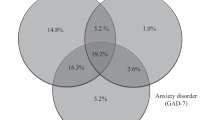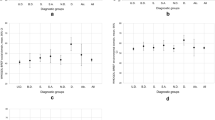Abstract
Background
Examinations of the role of demographic characteristics in quality of life (QOL) in psychiatric samples are not new. However, serious limitations of previous research have been that (1) QOL was not assessed according to current recommendations, (2) assessment of QOL was often hampered by a substantial overlap in content between symptoms and QOL measures, and (3) the majority of the study samples had quite specific characteristics hampering the generalizability of results, as a result of which clinical implications of the results remained unclear. The aim of the present study was to investigate explicitly the relationships between demographics and QOL in a sample reflecting the general population of psychiatric outpatients, QOL being assessed in a comprehensive, culturally sensitive, and subjective way, paying attention to the relative importance of its various facets. The main hypothesis was that these relationships would be rather weak.
Method
From a population of 533 adult Dutch psychiatric outpatients, 495 participants completed the World Health Organization Quality of Life (WHOQOL)-Bref for assessing QOL. Furthermore, several demographic characteristics were recorded.
Results
Statistically significant correlations were found between partner relationship, habitual status, work, and sick leave and the WHOQOL-Bref domains social relationships and environment. Psychological health was associated to partner relationship, educational level, and sick leave. The total amount of QOL variance explained by demographics was rather low.
Conclusion
Amongst factors determining QOL, demographic characteristics are relatively unimportant. Therefore, paying attention to demographics during psychiatric treatment will probably have little effect on improvement of QOL.
Similar content being viewed by others
References
Barry M (1997) Well-being and life satisfaction as components of quality of life in mental disorders. In: Katschnig H, Freeman H, Sartorius N (eds) Quality of life in mental disorders. Wiley, Chichester, pp 31–42
Bengtsson-Tops A, Hansson L (1999) Subjective quality of life in schizophrenic patients living in the community. Relationships to clinical and social characteristics. Eur Psychiatr 14:256–263
Bobes J, González MP (1997) Quality of life in schizophrenia. In: Katschnig H, Freeman H, Sartorius N (eds) Quality of life in mental disorders. Wiley, Chichester, pp 165–178
Breslin S (1991) Quality of life: how is it measured and defined? Urol Int 46:246–251
Browne S, Roe M, Lane A, Gervin M, Morris M, Kinsella A, Larkin C, Callaghan EO (1996) Quality of life in schizophrenia: relationship to socio-demographic factors, symptomatology and tardive dyskinesia. Acta Psychiatr Scand 94:118–124
Bullinger M, Anderson R, Cella D, Aaronson NK (1993) Developing and evaluating cross-cultural instruments from minimum requirements to optimal models. Qual Life Res 2:451–459
Chan GW, Ungvari GS, Shek DT, Leung JJ (2003) Hospital and community-based care for patients with chronic schizophrenia. Soc Psychiatry Psychiatr Epidemiol 38:196–203
Costa PT Jr, McCrae RR (1980) Influence of extraversion and neuroticism on subjective well-being: happy and unhappy people. J Pers Soc Psychol 38:668–678
De Vries J (1996) Beyond health status: construction and validation of the Dutch WHO quality of life assessment instrument. Ph.D. thesis, Tilburg University Press, Tilburg
De Vries J, Van Heck GL (1995) The Dutch version of the WHOQOL-Bref. (In Dutch: De Nederlandse versie van de WHOQOL-Bref). Tilburg University, Tilburg
De Vries J, Van Heck GL, The World Health Organization Quality of Life Assessment Instrument (WHOQOL-100) (1997) Validation study with the Dutch version. Eur J Psychol Assess 13:164–178
DeGenova MK (1993) Reflections of the past: new variables affecting life satisfaction in later life. Educ Gerontol 19:191–201
Gamma A, Angst J (2002) Concurrent psychiatric comorbidity and multimorbidity in a community study: gender differences and quality of life. Eur Arch Psychiatry Clin Neurosci 251:43–46
Gladis MM, Gosch EA, Dishuk NM, Crits-Cristoph P (1999) Quality of life: expanding the scope of clinical significance. J Consult Clin Psychol 67:320–331
Hays RD, Stewart AL, Sherbourne CD, Marshall GN (1993) The ‘states of weights’ dilemma in quality of life measurement. Qual Life Res 2:167–168
Hoekstra HA, Ormel J, De Fruyt F (2002) The NEO-PI-R/NEO-FFI personality inventory manual. Harcourt Test Publishers, Lisse
Jenkins CD, Jono RT, Stanton BA, Stroup-Benham CA (1990) The measurement of health-related quality of life: major dimensions identified by factor analysis. Soc Sci Med 31:25–33
Katschnig H, Angermeyer MC (1997) Quality of life in depression. In: Katschnig H, Freeman H, Sartorius N (eds) Quality of life in mental disorders. Wiley, Chichester, pp 137–148
Katschnig H, Krautgartner M (2002) Quality of life: a new dimension in mental health care. In: Sartorius N, Gaebel W, Lopez-Ibor JJ, Maj M (eds) Psychiatry in society. Wiley, Chichester, pp 171–191
Kim HK, McKenry PC (2002) The relationship between marriage and psychological well being: a longitudinal analysis. J Fam Issues 23:885–911
Kuyken W, Orley J, Hudelson P, Sartorius N (1994) Quality of life assessment across cultures. Int J Ment Health 23:5–27
Lahelma E (1992) Unemployment and mental well-being: elaboration of the relationship. Int J Health Serv 22:261–274
Lam J, Rosenheck RA (2000) Correlates of improvement in quality of life among homeless persons with serious mental illness. Psychiatr Serv 51:116–118
Laman H, Lankhorst GJ (1994) Subjective weightings of disability: an approach to quality of life assessment in rehabilitation. Disabil Rehabil 16:198–204
Lang A, Steiner E, Berghofer G, Henkel H, Schmitz M, Schmidl F, Rudas S (2002) Quality of life and other characteristics of Viennese mental health care users. Int J Soc Psychiatry 48:59–69
Lehman A (1983) The effects of psychiatric symptoms on quality of life assessments among the chronic mentally ill. Eval Program Plann 6:143–151
Marks GN, Fleming N (1999) Influences and consequences of well-being among Australian young people: 1980–1995. Soc Indic Res 46:301–323
McCoy M, Filson G (1996) Working off the farm: impacts on quality of life. Soc Indic Res 37:49–163
McCrae RR, Costa PT Jr (1991) Adding Liebe und Arbeit: the full five-factor model and well-being. Pers Soc Psychol Bull 17:227–232
Mercier C (1994) Improving quality of life of people with severe mental disorders. Soc Indic Res 33:165–192
Mercier C, Péladeau N, Tempier R (1998) Age, gender and quality of life. Community Ment Health J 34:487–500
Mookherjee HN (1998) Perceptions of well-being among the older metropolitan and non-metropolitan populations in the United States. J Soc Psychol 138:72–82
Power M, Harper A, Bullinger M, WHOQOL group (1999) The World Health Organization WHOQOL-100: tests of the universality of quality of life in 15 different cultural groups worldwide. Health Psychol 18:495–505
Pugliesi K (1995) Work and well-being: gender differences in the psychological consequences of employment. J Health Soc Behav 36:57–71
Richmond L, Filson GC, Paine C, Pfeiffer WC, Taylor JR (2000) Non-farm rural Ontario residents’ perceived quality of life. Soc Indic Res 50:159–186
Rusting CL, Larsen RJ (1998) Personality and cognitive processing of affective information. Pers Soc Psychol Bull 24:200–213
Salokangas RKR, Honkonen T, Stengard E, Koivisto AM (2001) To be or not to be married—that is the question of quality of life in men with schizophrenia. Soc Psychiatry Psychiatr Epidemiol 36:381–390
Sartorius N, Kuyken W (1994) Translation of health status instruments. In: Orley J, Kuyken W (eds) Quality of life assessment: international perspectives. Springer, Berlin Heidelberg New York, pp 3–18
Schneier FR (1997) Quality of life in anxiety disorders. In: Katschnig H, Freeman H, Sartorius N (eds) Quality of life in mental disorders. Wiley, Chichester, pp 149–164
Skevington SM, Lotfy M, O’Connel KA (2004) The World Health Organization’s WHOQOL-Bref quality of life assessment: psychometric properties and results of the international field trial. A report from the WHOQOL Group. Qual Life Res 13:299–310
Sullivan G, Wells KB, Leake B (1992) Clinical factors associated with better quality of life in a seriously mentally ill population. Hosp Community Psychiatry 43:794–798
Trompenaars FJ, Masthoff ED, Van Heck GL, Hodiamont PP, De Vries J (2005) Content validity, construct validity, and reliability of the WHOQOL-Bref in a population of Dutch adult psychiatric outpatients. Qual Life Res 14:151–160
WHOQOL Group (1994) The development of the World Health Organization quality of life assessment instrument (the WHOQOL). In: Orley J, Kuyken W (eds) Quality of life assessment: international perspectives. Springer, Berlin Heidelberg New York, pp 41–60
WHOQOL Group (1998a) Development of the World Health Organization WHOQOL-BREF quality of life assessment. Psychol Med 28:551–558
WHOQOL Group (1998b) The World Health Organization quality of life assessment (WHOQOL): development and general psychometric properties. Soc Sci Med 46:1569–1585
Winefield AH, Winefield HR, Tiggeman M, Goldney RD (1991) A longitudinal study of the psychological effects of unemployment and unsatisfactory employment on young adults. J Appl Psychol 76:424–431
Author information
Authors and Affiliations
Corresponding author
Rights and permissions
About this article
Cite this article
Trompenaars, F.J., Masthoff, E.D., Van Heck, G.L. et al. Relationships between demographic variables and quality of life in a population of Dutch adult psychiatric outpatients. Soc Psychiat Epidemiol 40, 588–594 (2005). https://doi.org/10.1007/s00127-005-0946-0
Accepted:
Published:
Issue Date:
DOI: https://doi.org/10.1007/s00127-005-0946-0




